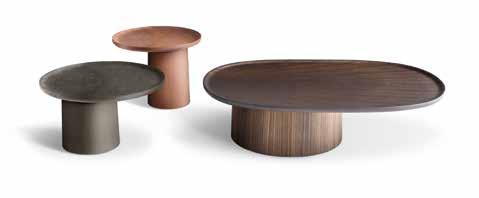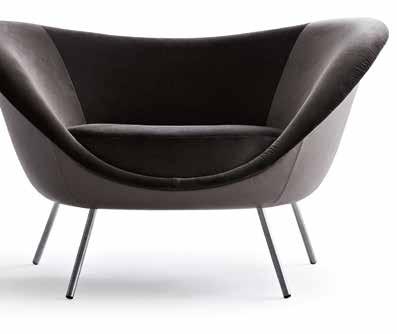
5 minute read
Molteni Goup
The Molteni Group, founded in 1934 by Angelo and Giuseppina Molteni in Giussano, Monza Brianza province, is Italy’s largest high-end industrial group in the furnishings sector offering 100% Italian made that appears on several ships is the D.151.4 chair by Gio Ponti, with walnut and brass legs. Architects and designers often choose items from the Molteni collection to add an extra touch of personality to their clients’ superyachts. Awareness of sustainability issues is encouraging products. It was launched as a simple artisanal workshop but soon the development of new global skills at all levels of the organisation, became a company. A lot has changed since those early days. The starting from the development stage of a new product, thinking about manufacturing is now industrial and international with exceptional its end-of-life condition and how to recycle its components. Natural technological innovation and constant investment in research and de- materials like wood and stone become recoverable in a virtuous cirvelopment. One thing has remained unchanged – the intrinsic quality cular economy. Raw and semi-finished materials are mainly sourced of long-lasting products, a philosophy that three generations of the from suppliers in the same region as the factory, almost without excepMolteni family has worked to uphold. Nowadays the Molteni Group tion within a radius of 150 km. This provides support for local industry is an example of entrepreneurial excellence, and it is one of the few and has a positive impact on pollution generated by transportation. organisations to implement a complete production cycle, becoming Since the 1970s the Molteni Group has comprised four brands, each a the home of expertise and flair in wood, first classic, then modern. In leader in its own sector - Molteni&C (home furniture), Dada (kitchens), the late 1950s the company was one of the few to transform its DNA Unifor (work environment solutions) and Citterio (partitions and ofand introduce the age of industrial design through collaborations with fice furnishings). In 2012 the company began re-issuing pieces from the most prestigious international architecture and design studios. the archive of Gio Ponti with targeted editions of his works. The year Quality and durability are what we in the company call our “magnifi- 2015 saw the opening of the Molteni Museum, designed by Jasper cent obsession”, now also regarded as a contribution to environmental Morrison, who is also the curator, with image coordination by Studio sustainability, with long-lasting products that gradually acquire value Cerri e Associati. The museum hosts 48 iconic products and original and will one day be passed on future generations as objects to be che- prototypes by the group’s companies. Molteni is now present in over rished for their great intrinsic worth. Through its Contract Division ninety countries with more than 700 sales points, 52 single-brand Molteni has now applied this emphasis on shape and materials to Flagship Stores promoting the Molteni philosophy, 973 employees, cruise ships with custom-made projects created alongside the most five production sites, fourteen showrooms and eleven commercial prestigious international architectural studios. One example of a piece subsidiaries on five continents. www.moltenigroup.com
Inspired by the International Modernism style, the two new cushions designed by the creative director of Molteni, Vincent Van Duysen, for Dada. Left, the Ration modular kitchen. Above, Intersection with refined details
Advertisement


Left, the D.154.2 chair, part of the Gio Ponti Collection by Molteni&C. Gio Ponti designed it for the villa owned by the Planchart collectors in Caracas between 1953 and 1957. Above, the Louisa coffee table in marble and wood by Vincent Van Duysen. Below, left, the GloveChair chairs, 2005, by Patricia Urquiola and the armchair with pouf from the Piccadilly collection by Rodolfo Dordoni, 2020



questions to Giulia Molteni
Molteni Group Head of Marketing and Communication
Has your furnishing philosophy changed over the past 10/20 years? Furnishing in general has undergone an important rethink involving all areas, from kitchen to lounge and bedroom. The emphasis is on comfortable, multifunctional objects. Living spaces have become a safe haven, sheltering us from an outside world full of uncertainty and change. Our offer is in this sense complete, with day systems, sliding doors and hideaway elements at the core of the new demands of contemporary living. How much do innovative technology and materials help in your production? Innovative technology and materials lie the heart of the Molteni Group’s strategy. Sustainability is a priority for the entire group and is based first of all on a concept of 100% Made in Italy. The company is adopting the requirements of the UN-approved Agenda 2030 for sustainable development. This year we’ve already taken the important step of eliminating polystyrene from our packaging, and we’ve invested in modern machinery that enables us to use only fully recyclable cardboard. What are the current trends in furnishing the lounge?The experience of living the home only as a place for rest and relaxation is bound to change. New priorities like home working will become part of our everyday life. The challenge will be to find the right balance among the various domestic environments, combining aesthetics and functionality. Configuring increasingly smart, dynamic spaces will be a crucial requirement. Does that mean multifunctional spaces? The interplay of home and office is at the centre of the Molteni Group’s projects. One example is the TDU, a project by UniFor design Studio Klass for both environments, and the residential world of Molteni&C and Dada provides an opportunity to rethink products designed for versatile domestic spaces that can adapt their function and shape to different contexts. How important is the idea of personalising your products according to client needs? The Octave sofa by Vincent Van Duysen is an example of the opportunities for personalisation offered by a seating item. It’s a modular system with rigorous lines, comprising elements that can be put together to create a variety of compositions. The Molteni Group’s production can be considered tailor made, defined by a cutting-edge industrial culture combined with an artisanal knowledge of time-honoured techniques, a profound knowledge of materials and a passion for research, experimentation and innovation.










